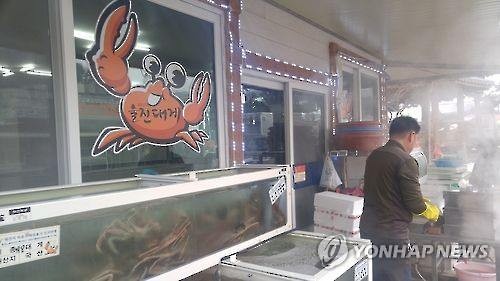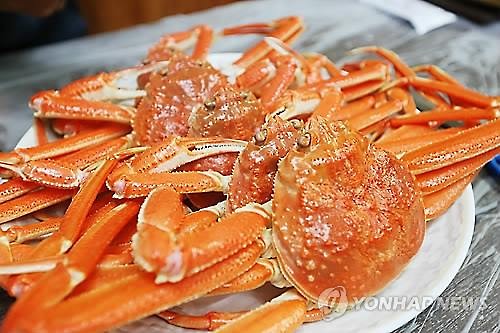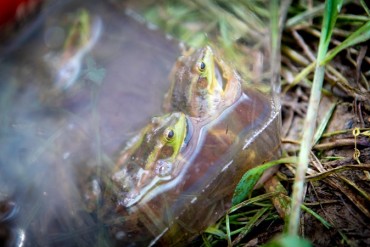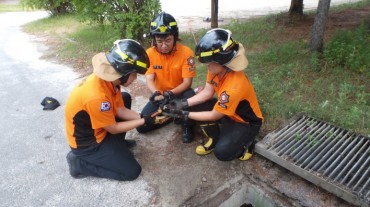ULJIN, March 3 (Yonhap) – A five-hour drive southeast from Seoul takes you to the tranquil seaside port of Hupo, Uljin, North Gyeongsang Province. This time of the year, the bucolic little town is bustling and brimming with seafood connoisseurs ready to gorge on crabs.
Reddish crustacean structures and paintings on the walls of buildings, in stark contrast with the crystal-clear blue sky, compete with each other to entice foodies who don’t mind miles-long bumper-to-bumper traffic to get their crab fix.
This crab-dedicated town turns itself into heaven for crab lovers with the “Snow Crab and Red Snow Crab Festival” in late February and early March – when the annual catch reaches its peak and the county’s proud specialty meets perfect conditions to arrive on dinner tables. After seven to eight months of closed season to protect crab breeding stocks, the crustaceans are at their meatiest and chewiest.’
Last Sunday, visitors to the town threw their expectant eyes upon “daege,” or snow crab, stacked inside a transparent water tank, haggling with sellers in waterproof aprons over a price that can range from 10,000 won (US$8) to 50,000 won per each. Prices are determined according to weight, size and color.
Once selected, the crabs are brought to a steamer — some in stainless steel and others in iron pots — for a process that is considered very important to determine the juicy taste. Crabs are put on a colander belly side up to keep the water inside, and steamed for around 25 minutes. In some restaurants, soju, a Korean distilled liquor, is mixed in the boiling water to neutralize the crab odor.
An adjacent local seafood restaurant is packed with crab lovers who prepare for the feast. Sitting on the floor cross-legged, poising over the table and rolling up their sleeves, they seem almost militant for the meal that requires the whole body to eat.
Among many different ways to enjoy the succulent seafood, unadulterated and steamed crabs are the most worshiped as they are considered the best way to celebrate crab’s natural flavors.’
Armed with crab forks and scissors — why would anyone need lobster or nut crackers that might send the snowy white flakes all over your body? — feasters cautiously crack open the upper shell. The first thing to do is to save the crab butter in a bowl for later use, followed by removing the meat from the body and legs. In some establishments, steamed crabs are served in bits and pieces to save the patrons from too much trouble.
For some, the strenuous process of dismantling a crab and plucking the final flesh from the claws is just part of the fun.
“It is troublesome. But it is worth it because it tastes so good,” says Cha Eun-mi, who took a bus for four hours to visit the county for the first time with her boyfriend.
Diners have already dropped efforts to keep up table manners amid finger licking, with grayish crab juice dripping down their arms and bits of white meat lingering on the chin. After devouring all the flesh with forks and chopsticks and slurping down the salty-sweet juice comes the highlight of the meal: fried rice mixed with crab butter and Korean staple kimchi, topped with pieces of crisply seasoned laver. The rice served in the upper shell, tart and aromatic, cleanses down the buttery, fishy taste. For those whose appetite isn’t satisfied yet, a hot, fiery crab soup, laden with vegetables, is another great variety worth a try.
Leaving behind files of empty shells on the table and patting the belly contentedly, now is the time for visitors to head out to the seaside stalls and special stages to soak up the festive vibe.’
The 16-year-old festival, which attracts hundreds of thousands of visitors annually, dedicates itself to keeping Uljin’s reputation as South Korea’s best place to enjoy crabs, an honor that traces back to the Joseon Dynasty (1392-1910). According to the county, a royal order was placed some 600 years ago for crabs from the region to be used for imperial cuisines. Snow crabs from the waters of Uljin have a thinner shell, white abdomen and sweet and chewy meat, rich with essential amino acids and protein.
Kang Jin-cheol, secretary-general of the festival organizing body, stresses Uljin’s long-standing reputation as the ultimate destination for a crab feast.
“Yeongdeok is also known for snow crab but it got popular in large part because its convenient location made the county flourish as a distributor,” says the 54-year-old, referring to the southern county some 36 km down the coastline from Uljin, which stages its own annual crab festival in early spring.
Back at the festival, people are fixated on Korean traditional dance performances, oblivious to the decades-old squabbles between the two adjacent counties over which gets the crab crown. Against the sky that changes color at sunset, outdoor tables are quickly filled with those who feel peckish after a long leisurely walk around the festival venue. Koreans’ appetite for crabs is insatiable: People start their second round with snacks ranging from crab-flavored breads to crab noodles.
The four-day crab festival officially ended on March 1 — which is far from saying that the feast is over. After all, fresh crabs are available until late spring.
(Yonhap)










Reddish crustacean structures and paintings on the walls of buildings, in stark contrast with the crystal-clear blue sky, compete with each other to entice foodies who don’t mind miles-long bumper-to-bumper traffic to get their crab fix Fox Farm .
Thanks